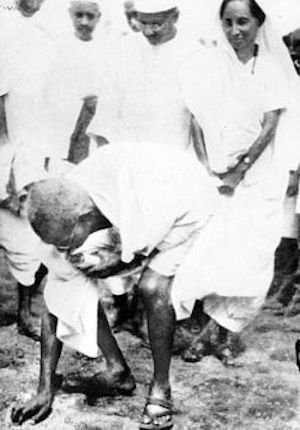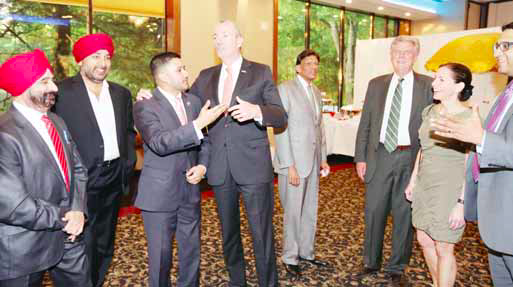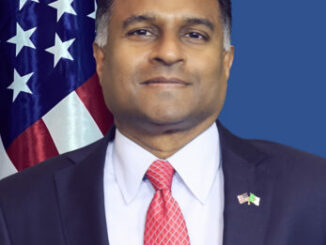

The crises in Indian democracy and in global politics send one immediately to consult Gandhi.
Truth, Satya, was the central axis of the Gandhian system of thought and practice. For Mohandas Karamchand Gandhi, everything turned on Truth — satyagraha, swaraj, ahimsa, ashram, brahmacharya, yajna, charkha, khadi, and finally, moksha itself. In a fine introduction to a new critical edition of the Mahatma’s An Autobiography or The Story of My Experiments with Truth, Tridip Suhrud, closest to Gandhi among all contemporary scholars, lays out the intricate web of ideas arranged around the axial principle of Truth: “Truth is not merely that which we are expected to speak and follow. It is that which alone is, it is that of which all things are made, it is that which subsists by its own power, which alone is eternal.”
In a recent interview, Mr. Suhrud points out that Indians today continue to have “the need that he should always be available to us. When there is a crisis in our collective life, we expect Gandhi to provide an answer.” Both of Mr. Suhrud’s insights — that Truth is the key to Gandhi’s philosophy, and that we rely on Gandhi even decades after his death and long after his supposed lapse into political irrelevance — are essentially correct. I started making a note of the crises in Indian democracy and in global politics that sent one immediately to consult Gandhi.
“For Mohandas Karamchand Gandhi, everything turned on Truth — satyagraha, swaraj, ahimsa, ashram, brahmacharya, yajna, charkha, khadi, and finally, moksha itself”.
Truth alone triumphs?
The ongoing controversy in the United States about the proposed appointment of Federal Judge Brett Kavanaugh to the U.S. Supreme Court as the nominee of the Republican Party, even as he stands accused of sexually assaulting Christine Blasey Ford, in 1982, when they were both teenagers, hinges exactly on the truth of her testimony versus his defense. Only one can be true. As became clear in the Senate hearings on September 27, the palpable veracity of Professor Ford’s account over Judge Kavanaugh’s denial would likely still not change the Republican Party’s nomination of him (the outcome of the proceedings, including an FBI investigation, is pending as this article goes to press).
Effectively, the U.S. appears on the verge of replacing Truth with perjury as an acceptable value, even in the apex court of the criminal-justice system, shaking the very bedrock of American constitutionalism. When Truth is rendered negotiable and dispensable, the balance of justice — in this case, between genders and between political parties — is disastrously upset. The scales tip wildly without any kind of mechanism to orient men and women or Democrats and Republicans back into an equitable relationship with one another within a shared political context that ought to be egalitarian and fair.
Like other democratic institutions in the Donald Trump presidency, the U.S. Supreme Court seems poised on the verge of destruction. Arguably Americans, too, could have recourse to Gandhi, though perhaps not in the way that we in India might. Mr. Suhrud describes how Gandhi strained to hear the “small, still voice” within himself, the voice belonging to one he called “antaryami”, “atma” or “God” — an inner prompt, the self as a guide and a compass – so that he could keep moving ever closer to Truth.
It was this voice that he followed, sometimes to the bafflement of others who could not hear it. This was the voice that made him undertake life-threatening fasts his health wouldn’t permit; withdraw from active politics at the most crucial junctures of India’s anti-colonial struggle; leave factual errors and narrative inconsistencies in texts he wrote after readers had pointed out obvious mistakes; and, most difficult to understand, embark on life-long ordeals of a sexual nature, involving not just his own celibacy and asceticism, but also that of his wife Kasturba, his fellow Ashramites, and his sons and their families.
Even close and loyal associates like Jawaharlal Nehru and Vallabhbhai Patel were often confounded by Gandhi’s actions and decisions; more skeptical and antagonistic peers like M.A. Jinnah and B.R. Ambedkar couldn’t make sense of his motivations at all. In his monumental new history, Gandhi: The Years that Changed the World, 1914-1948, Ramachandra Guha delves deep into these knotty episodes, where the voice of the Mahatma’s interior conscience and the compulsions of nationalist politics pull in opposite directions, and no power on earth is able to steer Gandhi away from his self-charted path towards Truth.
Mr. Guha calls Gandhi’s move to have his young grand-niece Manu sleep next to him, as he travelled through ravaged Hindu and Muslim settlements in Bihar and Bengal during the height of communal violence on the eve of Partition, “the strangest experiment”. No matter what the reactions of his colleagues, for Gandhi it was not strange, precisely because it was one of his ‘experiments with truth’ (in Gujarati, satya na prayogo).
Home and the world
Of late, many musicians in south India have faced vicious attacks from rightwing Hindutva groups for singing hymns and psalms, thereby allegedly hijacking “Hindu” Carnatic music for “Christian” evangelical aims. This despite the fact that the violin, central to the Carnatic system in modern times, is a European gift to Indian music, and both Christian and Muslim religious lyrics and poetry have been a constitutive part of the Carnatic repertoire throughout the 20th century, if not before.
Gandhi made great use of the Bible in his prayers, teachings, writings and Ashram liturgies. He was often accused of being a crypto-Christian. However, he flatly refused to give preference to the Vedas over the Bible. Mr. Suhrud quotes from Vol. 31 of the Collected Works: “He is no Sanatani Hindu who is narrow, bigoted and considers evil to be good if it has the sanction of antiquity and is to be found supported in any Sanskrit book.”
Outside India but not far from it, Indologist David Shulman has been reporting consistently on the brutal violence of hardline Zionist settlers as well as the Israeli army against unarmed Arab shepherds and villagers in the Jordan Valley. Mr. Guha delves into Gandhi’s difficult correspondence with philosopher Martin Buber and the intellectual J.L. Magnes in 1938-1939, just before the Kristallnacht. Gandhi advised European Jews to relocate to Palestine and make it their homeland only with the cooperation and goodwill of native Arabs, and not otherwise. This appalled even sympathetic Jews like Buber and Magnes, who had admired and supported Gandhi at the time of the Salt March in 1930, before the Nazi takeover of Germany.
How could Gandhi oppose the Zionist project, with Jews being sent to death camps in Hitler’s murderous regime? But now the tables are turned, and a rightwing Israeli state under Benjamin Netanyahu seems hell-bent on exterminating the Palestinians. Gandhi’s counter-intuitive Truth informs the civil disobedience, passive resistance and non-violent protest of both Arab and Jewish activists who oppose the continuing occupation and takeover of dwindling and defenseless Palestinian territories by bellicose Israeli forces.
The multilingual translator, editor and interpreter Suhrud (who works in all three of Gandhi’s languages, Gujarati, English and Hindustani, and has earlier produced a critical edition of Hind Swaraj), and the historian and biographer Guha (who has already written two other massive books in the past decade, about Gandhi in the first phase of his life, and about postcolonial India, “after Gandhi”), have together provided ample materials this year — leading up to the 150th anniversary of Gandhi’s birth in October 1869, and the 70th anniversary of his assassination in January 1948 — that we can continue to consult Gandhi on all manner of issues that may trouble our individual or collective conscience. It might have been “small” and “still” in his own perception, but even today, Gandhi’s is the voice that is great within us.
(The author is a Fellow at the Centre for the Study of Developing Societies, New Delhi).





Be the first to comment